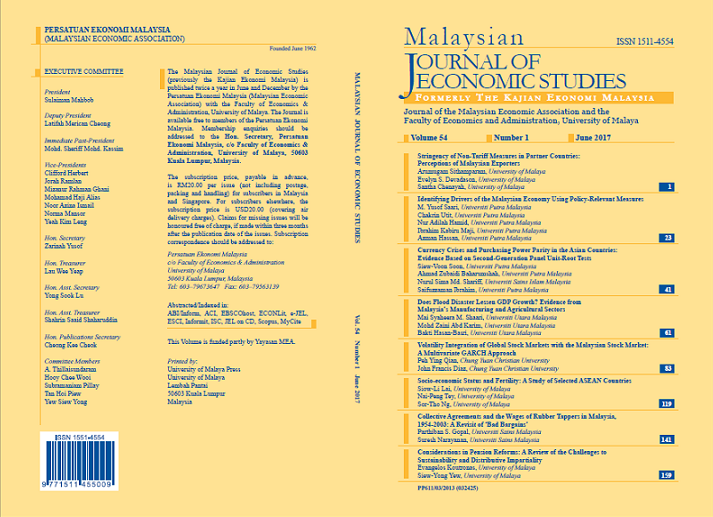Volatility Integration of Global Stock Markets with the Malaysian Stock Market: A Multivariate GARCH Approach
DOI:
https://doi.org/10.22452/MJES.vol54no1.5Keywords:
Bursa Malaysia, global stock markets, MGARCH, stock market returns, volatility transmissionAbstract
The research studies short- and long-run volatility dynamics between Malaysia’s stock market and 14 developed and developing major stock markets in the
five different regions of America, Europe, Africa, Asia and Oceania. The paper uses three multivariate generalised autoregressive conditional heteroscedasticity (MGARCH) models, namely, the Baba, Engle, Kraft and Kroner (BEKK) model; constant conditional correlation (CCC) model; and the dynamic conditional correlation (DCC) model to examine volatility relationship of different stock markets to the Malaysian stock market. Findings show that the long-term volatility relationship of Malaysia’s Kuala Lumpur Stock Exchange Index’s volatility with the UK’s FTSE 100, Germany’s DAX and France’s CAC 40 found in the CCC and DCC models is a result of a long-term free trade agreement signed between Malaysia and the European countries. Unstable volatility relationship is found between Malaysia and China’s stock markets. Similar situations are observed in Malaysia’s steady or unstable economic relationships with the other countries stock markets, which can be either a product of strong trading and investing partnerships or political and social conflicts. The BEKK model confirms these volatility spillovers, and concludes that volatilities are not only determined by their own lagged values, but cross-volatility spillovers from other countries also exist. Results show that most of the stock indices have significant spillover effects on the stock market of Malaysia, which confirms evidence of growing market integration. In general, a study on volatility transmission plays an important role in identifying vulnerabilities of certain stock markets against other markets, which helps in determining better investing decisions that can minimise losses, and can even improve returns depending on the hedged position taken by the investor.

